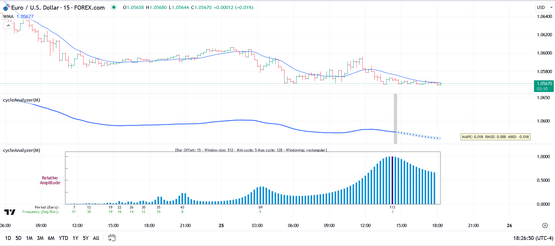
mesaForecaster for TradingView uses autoregressive (AR) algorithms and digital signal processing (DSP) techniques to provide you with several different time series analyses.
As the name suggests, forecasting is the primary function of the indicator. But it also provides several cycle-analysis plots (i.e., top 3 cycles, dominant cycle only, and composite) as well as a power spectrum plot. All of these are discussed in more detail in the Overview section. To perform these tasks, mesaForecaster for TradingView uses a combination of MESA and MEM time series analysis techniques.
Introduction to MESA/MEM
Modern time series analysis offers a plethora of techniques for understanding the underlying patterns and trends in data, with Maximum Entropy Spectral Analysis (MESA) and Maximum Entropy Method (MEM) standing out for their unique approaches. These techniques are especially crucial in the financial domain, where security prices are influenced by a multitude of factors, resulting in complex and often non-linear trends.
MESA and MEM utilize the concept of entropy (which is a measure of uncertainty or disorder) to derive spectral estimates, aiming to provide the most unbiased and high-resolution representation of the data’s spectral content.
Maximum Entropy Spectral Analysis (MESA) and Maximum Entropy Method (MEM) are often used interchangeably in literature, but they can have distinct meanings depending on the context.
Maximum Entropy Spectral Analysis (MESA)
MESA is a specific application of the Maximum Entropy Method in spectral analysis. The goal of MESA is to estimate the power spectrum of a time series. The technique is based on the principle of maximizing the entropy of the power spectrum under the constraint of the known autocorrelations of the time series. By doing so, MESA produces a high-resolution and unbiased spectral estimate, which is particularly useful for identifying closely spaced or weak signals that might be missed by other spectral estimation methods.
Maximum Entropy Method (MEM)
MEM is a more general technique that can be applied to various problems in signal processing, statistics, and other fields. It is based on the principle of maximizing the entropy of a probability distribution or a power spectrum under certain constraints. In signal processing, MEM can be used for spectral analysis, image reconstruction, and other applications. When MEM is applied to spectral analysis, it becomes MESA, but MEM itself has a broader range of applications beyond spectral analysis.
Distinction and Application in Financial Time Series Analysis
In the context of security price analysis, MEM (and by extension, MESA) can be applied to uncover the underlying spectral components of a time series, identify various cycles, and make forecasts. The distinction between MESA and MEM becomes crucial when we consider that MEM’s capabilities extend beyond spectral analysis. While MESA is explicitly focused on providing a high-resolution power spectrum, MEM’s broader framework can be utilized to create models and make predictions, offering a comprehensive toolkit for analysts and traders to extract insights from financial data.
In summary, while MESA is a subset of MEM focused specifically on spectral analysis, MEM represents a broader set of techniques and principles that can be applied to a variety of problems, including but not limited to spectral analysis. The application of MEM in security price analysis offers a powerful means of uncovering hidden patterns, making accurate forecasts, and gaining a deeper understanding of market dynamics.
Benefits of MEM in Financial Time Series Analysis
The Burg algorithm, a popular implementation of MEM and one which we use in our indicator, is highly regarded for its ability to produce accurate and high-resolution spectral estimates. In the context of security price analysis, this translates to an enhanced ability to discern various cyclical components within the price movements, even when these cycles are closely spaced or have varying amplitudes. The Burg algorithm’s minimization of forward and backward prediction errors leads to a power spectrum that accurately represents the underlying processes, regardless of their complexity.
MEM’s capabilities extend beyond cycle identification, offering robust forecasting tools for future price movements. By fitting an autoregressive model to the time series data, MEM provides a foundation for predicting future values based on the identified patterns and trends. This is particularly beneficial for traders and analysts, as it aids in making informed investment decisions, managing risks, and identifying potential trading opportunities.
The method’s ability to reveal the power spectrum of a time series not only aids in identifying dominant cycles but also assists in understanding the periodic nature of financial time series, which is crucial for devising trading strategies that are in sync with market rhythms. In essence, MEM, powered by the Burg algorithm, stands as a powerful spectral analysis technique, transforming security price data into actionable insights and forecasts.
Please refer to the Overview topic for instructions on how to load and use the mesaForecaster indicator in TradingView.
|
Note: In the documentation that follows all images/thumbnails are "clickable". So if a particular image is too small for you to see clearly, just click on it and a larger version will be displayed. You can adjust the font size and/or print individual sections of this documentation by clicking on the () icon that you see at the top-right of every page. Keyword index and topic search features are available as well. Just click on the tabs that you see above the table of contents that is displayed to the left. While best viewed in a desktop browser, this documentation is in a responsive format and can also be viewed on phones and tablets. |
If you have comments, questions, or suggestions on how we can improve our product, please send an email to support@sr-analyst.com and reference mesaForecaster for TradingView in the subject line.



